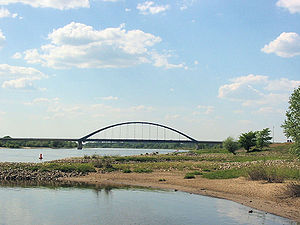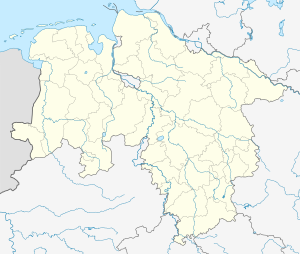Elbe bridge Dömitz (street)
Coordinates: 53 ° 8 ′ 36 ″ N , 11 ° 13 ′ 42 ″ E
|
|
||
|---|---|---|
| Convicted | Bundesstrasse 191 | |
| Subjugated | Elbe , km 505.7 | |
| place | Doemitz | |
| construction | Tied arch bridge | |
| overall length | 969.7 m | |
| width | 20 m | |
| Longest span | 178 m | |
| Construction height | 30 m | |
| building-costs | 52.4 million DM | |
| start of building | 1991 | |
| completion | 1992 | |
| location | ||
|
|
||
The Elbe bridge Dömitz is a 970 m long road bridge over the Elbe . The structure west of Dömitz is part of the federal highway 191 from Uelzen to Ludwigslust and is the only road bridge in an approximately 115 kilometer long Elbe section between Wittenberge and Lauenburg. It spans the Elbe and the diked foreland with two lanes. The clear passage height for ships is 8 m at the highest navigable water level.
The building was erected for the first time between 1934 and 1936. In 1945 the river bridge was destroyed by an air raid. Since the building crossed the inner-German border , it was not rebuilt in the following decades. Between 1991 and 1992 a new bridge train was built at the same place, which was finally opened to traffic on December 18, 1992 as the first new bridge over the Elbe after reunification . The bridge has since been considered a symbol of reunification.
Bridge 1936 to 1945
Since there was no fixed road connection across the Elbe between Hamburg and Wittenberge , it was decided in 1934 to build an Elbe crossing at Dömitz for long-distance traffic between the Baltic Sea region and Hanover. The steel bridge had a total length of 960 m. It consisted of the Strombrücke, an arched tied bridge spanning 156 m with a two-span foreland bridge to the north. The southern approach bridge, a four-web solid wall girder construction, had 16 fields and was divided into four sections by joints. The main girders in a bridge section were a welded structure for the first time in Germany. The roadway was constructed with laid concrete slabs and was designed for two lanes with a total of 6.5 m wide and two footpaths, each 1.25 m wide. The construction costs amounted to 3.3 million Reichsmarks, 3400 tons of structural steel were used.
In a US air raid on April 20, 1945, the river bridge and the neighboring fields, which were connected by a common stiffening beam, were destroyed. The following bridge sections, separated from the collapsed bridge section by a hinge, remained intact.
The southern foreland bridge on the west German side was restored to the extent that it was accessible to pedestrians and served as a lookout point. At the end above the pillar there was a display board and a telescope with a view of the GDR side. The remainder of the bridge on the opposite side was a guard post for the GDR border troops.
At the junction of the B 191 with the B 195 , about one kilometer behind the eastern abutment, a monument was created as part of the new bridge construction, which consists of a repositioned pillar and a few meters of superstructure of the first foreland bridge construction.
Bridge from 1991
After reunification, an examination of the bridge superstructures that were still in place and the pillars showed that repairs made no economic sense. Therefore, these components were torn down and replaced by a new building on the same street axis. However, the new pillars were moved away from the old pillars in the longitudinal direction of the bridge.
With the help of sheet pile wall boxes , the flat foundations of the pillar disks were made, which have a head width of 1.5 to 2.0 m with a tightening of 20: 1. The two dividing pillars between the river bridge and the approach bridges are 2.5 m wide.
The number of fields of the new bridge corresponds to 19 of the previous bridge. The approach bridges are now prestressed concrete structures with a superstructure that has the continuous beam as a structural system in the longitudinal direction . In the transverse direction, the superstructure has a single-cell box girder cross-section with a 15.85 m wide carriageway slab and inclined webs. The construction height is 2.05 m in the first eleven fields of the southern approach bridge, increases to 3.05 m in the three following fields and is constant in the remaining fields. The prestressing consists of internal tendons in the longitudinal and transverse directions . The spans for the foreland bridge south are 33.0 m + 11 × 40.5 m + 52.3 m + 55.0 m + 58.4 m + 0.6 m and for the foreland bridge north 0.6 m + 49.4 m + 38.8 m.
There is a steel arched bridge over the Elbe with a span of 178 m. The parabolic arches are inclined 11 ° to the vertical in their plane and have a vertex height of 27 m. The two 3.41 m high stiffening beams with hangers, which consist of round steel profiles with a maximum diameter of 130 mm, are removed at a distance of 11.28 m over these. The seamless reinforced concrete deck is 180 m long and 32 cm thick. It is connected to the transverse girders and was the first in Germany not to be prestressed in an arched bridge .
On October 3, 2010, a memorial plaque was unveiled on the bridge to commemorate the victims of the bombing raid on the bridge in 1945.
Construction work
The first fields of the prestressed concrete bridge with a constant construction height were made with a feed scaffold , the others on a falsework . The tied arch bridge was delivered in parts with a maximum weight of 65 t and installed on the route behind the eastern abutment. The 2100 t heavy construction was pushed in with the help of four sliding carriages and four pontoons.
Building material consumption
1,831 tons of structural steel, 24,300 m³ of concrete , 1,756 tons of reinforcing steel and 480 tons of prestressing steel were used for the bridge . The construction costs amounted to 52.4 million DM.
Specialty
A metrological monitoring showed exceptionally strong vibrations on the slightly inclined round steel hangers as singular events that led to fatigue cracks on the hanger connections within a year. The vibrations occurred with the simultaneous action of rain and wind. There were so-called rain-wind-induced vibrations, a phenomenon that has not yet been observed with almost vertical hangers. That is why dynamic vibration dampers were subsequently installed on the trailers and the trailer connection points were reinforced.
literature
- Federal Ministry of Transport: Bridges on the federal trunk roads 1994 . Verkehrblatt-Verlag Dortmund, ISBN 3-89273-070-9 .
- Hagen Jung: A symbol of unity - the creation of the new Dömitz road bridge . Köhring & Co. Lüchow, 1993, ISBN 3-926322-17-9 .
- Gerd Lüesse: The restoration of the Elbe bridge Dömitz. In: Bauingenieur Heft 12, vol. 1992, pp. 565-573.
- G. Lüesse, H.-D. Schrodt, T. Gottschalk: The restoration of the Elbe bridge Dömitz. In: Bauingenieur Heft 12, year 1993, pp. 521-532.
- Gerd Lüesse, Hans Ruscheweyh, Constantin Verwiebe, Gerhard H. Günther: Rain-wind-induced oscillation phenomena at the Elbe bridge in Dömitz. In: Steel construction. Volume 3, J. 1996, pp. 105-114.
- Jürgen Scharnweber: The Dömitzer Elbe bridges . Köhring & Co. Lüchow, 1995, ISBN 3-926322-14-4 .
See also
Web links
Individual evidence
- ↑ Schweriner Volkszeitung: When memories don't let go , October 4, 2010
| upstream | Bridges over the Elbe | downstream |
| Elbe bridge Dömitz (railway) | Elbe bridge Dömitz (street) |
Lauenburg bridge over the Elbe |



